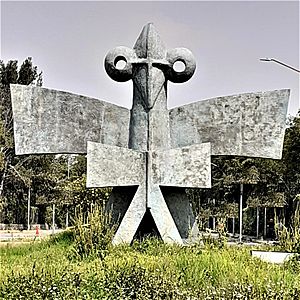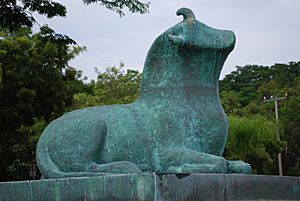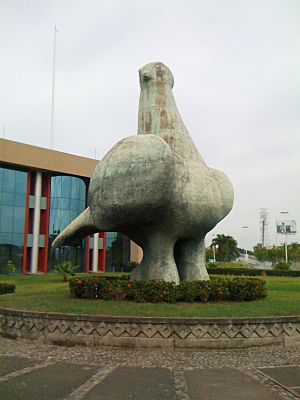Juan Soriano (artist) facts for kids
Juan Soriano (born Juan Francisco Rodríguez Montoya; August 18, 1920 – February 10, 2006) was a Mexican artist. He was known for his amazing paintings, sculptures, and work in theater. Juan Soriano was a child prodigy, meaning he was very talented from a young age. His career started early, and he became famous quickly. Many writers wrote books about him.
His art was shown in the United States and Europe. He also had major shows in Mexico at places like the Museo de Arte Moderno and the Palacio de Bellas Artes. You can find his huge sculptures in different parts of Mexico and Europe. He received many awards for his work. These include Mexico's National Art Prize and France's Legion of Honour.
Contents
Life of Juan Soriano
Juan Soriano was born Juan Francisco Rodríguez Montoya in Guadalajara, Mexico. His parents were Rafael Rodríguez Soriano and Amalia Montoya Navarro. From childhood, he started calling himself Juan Soriano. He preferred to use his father's mother's last name. He said his family was "eccentric," meaning a bit unusual.
Early Art Training
He was a child prodigy. In 1933, his sister introduced him to the painter Alfonso Michel Martínez. Alfonso taught him about modern art styles like Expressionist and neo Baroque painting. Juan then studied with Francisco Rodríguez “Caracalla” at the Evolución Studio in Guadalajara. Other famous artists like Raúl Anguiano also trained there.
During this time, he often visited the home and shop of Jesús Reyes Ferreira. Reyes gave him work making decorated wrapping paper. Juan found this work hard. But, being there allowed him to meet artists like Luis Barragán. He also saw European art in books and magazines. He discovered portraits by José María Estrada, which Reyes collected. Juan also went to his first museum and started reading classic books.
Moving to Mexico City
His first art show helped him meet artists like José Chávez Morado and María Izquierdo. They encouraged him to move to Mexico City. He moved there in 1935 at age fifteen with his sister Martha. In Mexico City, he made many lifelong friends with artists, writers, and thinkers. Juan said these friendships were one of the greatest treasures of his life.
His friends included famous people like Octavio Paz (who wrote about him). He was also friends with Frida Kahlo and Salvador Novo. He loved poetry and writing. He was part of a group that met regularly with Octavio G. Barreda. He also worked with magazines like El hijo prodigo.
Travels and Later Life
Juan Soriano visited Rome for the first time in 1952. In 1954, he visited Crete and painted Apolo y las musas (Apollo and the Muses). He lived in Rome again from 1969 to 1975. This allowed him to study classical art.
In 1963, he had a car accident. He painted a picture about it called El accidente (The Accident).
In 1974, Soriano met Polish dancer Marek Keller in Paris. This was the start of a long partnership. Juan Soriano worked all the time and only cared about his art. He often left other parts of his life messy. Marek Keller helped him manage his affairs and bring order to his life. They lived together in Mexico City and Paris until Juan's death. Since then, Keller has worked to share Juan Soriano's art with the world.
Juan Soriano passed away in 2006 at age 85 in Mexico City.
Juan Soriano's Career
Juan Soriano started his art career very early, and he became famous quickly. His first art show was at the Guadalajara Museum. This led him to move to Mexico City in 1935. From 1936 to 1937, he studied at the Escuela Noctura de Arte para Obreros. His teacher, Santos Balmori, helped him join the Liga de Escritores y Artistas Revolucionarios (LEAR). A small show at the end of this course at the Palacio de Bellas Artes brought him to the attention of Inés Amor. However, he did not stay with LEAR for long. He left in 1938 because he did not like its politics.
Exhibitions and Shows
His first solo art show was in 1936 at the Galería de Arte Mexicano in Mexico City. After that, he had many more shows. In the 1940s, he showed his art in New York and Philadelphia. In the 1950s, he had many shows in Europe, starting in Rome. He also had shows in Mexico. In 1959, he had his first big look back at his work (retrospective) at the Museo de Arte Moderno.
In the 1960s, he had another important show at the Palacio de Bellas Artes. He also showed a series of portraits where he only used Lupe Marín as his model. In the 1970s, he received money from Fundación Cultural Televisa. This allowed him to create many large and small artworks. These were then shown at the Museo de Arte Moderno. His last major shows before he passed away were in Miami, Madrid, and Rome.
Monumental Sculptures
During his career, Juan Soriano created many huge sculptures. You can find these in Mexico and Europe. Some famous ones include:
- El Toro (The Bull) in Villahermosa (1987).
- La Paloma (The Dove) at the MARCO Museum in Monterrey (1989).
- La Ola (The Wave) for the World Trade Center in Guadalajara (1989).
- La Luna (The Moon) for the National Auditorium in Mexico City (1993).
- Two sculptures for the Expo Hannover 2000 in Germany.
- Several of his works are in a park in Warsaw.
Theater and Other Works
From the 1930s to the 1960s, Soriano spent a lot of time working in theater. He started as a child with puppets. He worked with a group he helped create called Poesís en Voz Alta. This group was known for making theater more free in Mexico. Most of his theater work was designing sets and costumes. He worked for places like the Teatro del Sindicato de Electricistas. In the 1940s, he wrote a ballet called El pájaro y las doncellas (The Bird and the Maidens).
Juan Soriano also taught art soon after he moved to Mexico City. He taught at the Escuela Primaria de Arte. From 1961 to 1962, he taught ceramics.
He loved poetry and was friends with many writers. This led him to illustrate many books. In 1953, he illustrated Homenaje a Sor Juana. In 1967, he illustrated El Bestiario. He also illustrated the cover of Octavio Paz's book Xavier Villarrutia en persona y en obra in 1979.
Awards and Recognitions
Juan Soriano received many awards and honors for his art during his life and after his death.
- In 1950, he won first prize at the Salón de Invierno.
- In 1957, he received the José Clemente Orozco Award.
- In 1985, for his 50th year as an artist, big shows were held to celebrate him.
- In 1987, he received the Premio Nacional de Arte (National Art Prize). France also made him a member of the Chevalier des Arts et Lettres.
- In 1997, the Museo Nacional Centro de Arte Reina Sofia in Madrid held a big show of his work.
- In 2000, many of his huge sculptures were shown in the Zócalo in Mexico City for his 80th birthday.
- In 2004, France made him an officer in the Legion of Honour.
- In 2005, he received the Premio Velázquez de Artes Plásticas from Spain. He also received an honorary degree from the Universidad de Colima.
- His last award while alive was from the Polish government.
In 2004, he and his partner Marek Keller started the Fundación Juan Soriano and Marek Keller. Other places have been named after him, like the Galería Juan Soriano. In 2012, the Juan Soriano Sculpting Prize was created.
Juan Soriano's Artistry

Juan Soriano's art included paintings, sculptures, ceramics, drawings, illustrations, and tapestries. He also designed sets and costumes for plays. Many writers, like Octavio Paz, loved his work. Art critic Luis Cardoza y Aragón called him "a poet, a deep painter of visual stories."
Soriano believed that art should not be political or too serious. Jesús Reyes Ferreira was an early influence on his work. His painting style changed in the mid-1950s. Works like La Carrera de bicicletas (The Bicycle Race) show this change. In the 1960s, he tried out abstract painting for a short time.
He was a well-known portrait painter. His portraits were clear but also a bit mysterious. Many of his very early works were portraits. One famous series of portraits was of the model and writer Lupe Marín in the 1960s. Soriano said that painting was not just a copy of life. He believed it was a "form of intuition that goes beyond conscious life."
From 1951 to 1953, he worked on ceramics in Rome. In the 1960s, he also started creating works in bronze.
His graphic work (prints and drawings) is less known. He started making them in 1944 and continued until 2001. In 1975, he got a job to do graphic work in Paris. This made him split his time between Paris and Mexico City. One special series of his graphic works was based on stories by Juan Rulfo.
In 2003, he designed tapestries with a death theme for a workshop in Guadalajara.
Juan Soriano Museum
The Museo Morelense de Arte Contemporáneo (MMAC) Juan Soriano opened on June 8, 2018. It is located in Cuernavaca, Morelos, Mexico. The museum was designed by JSa Arquitectura. Its location connects an old part of Cuernavaca to the city's historic center.
It is the largest art space in Morelos state. It has two galleries for temporary shows, an open forum, a library, a sculpture garden, and workshops.
The museum covers 4,455 square metres (47,950 sq ft). It cost about MXN $300 million (around US$14.8 million). It holds 1,200 of Soriano's artworks. These include sculptures, paintings, drawings, and photographs.
The museum has faced some disagreements. Before it opened, a group sued. They said the cost had gone up from $195 million pesos to $300 million pesos. They also complained that the museum focuses on an artist from western Mexico. They felt it ignored local artists.
Selected works
- The Moon, a sculpture outside the National Auditorium in Mexico City.
- La Paloma (The Dove), sculptures in Colima and Monterrey.
- La Capilla del Rosario (The Rosario Chapel) in Mexico City.
See also
 In Spanish: Juan Soriano para niños
In Spanish: Juan Soriano para niños






